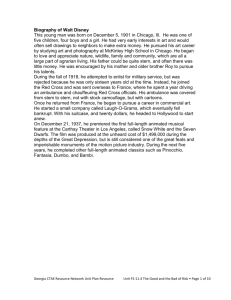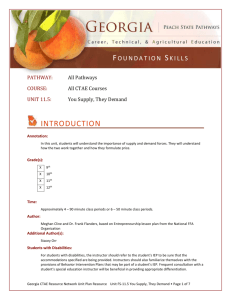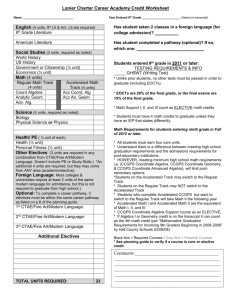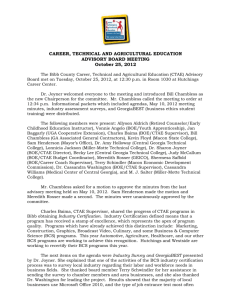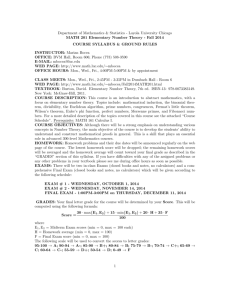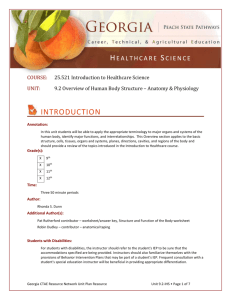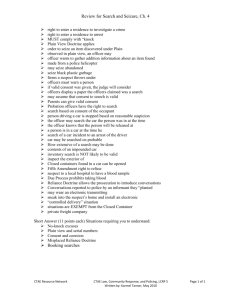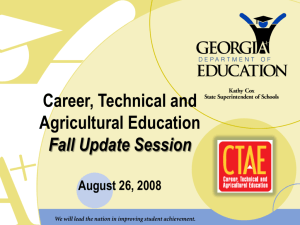The ABC's of CTAE and Academic Curriculum Integration
advertisement
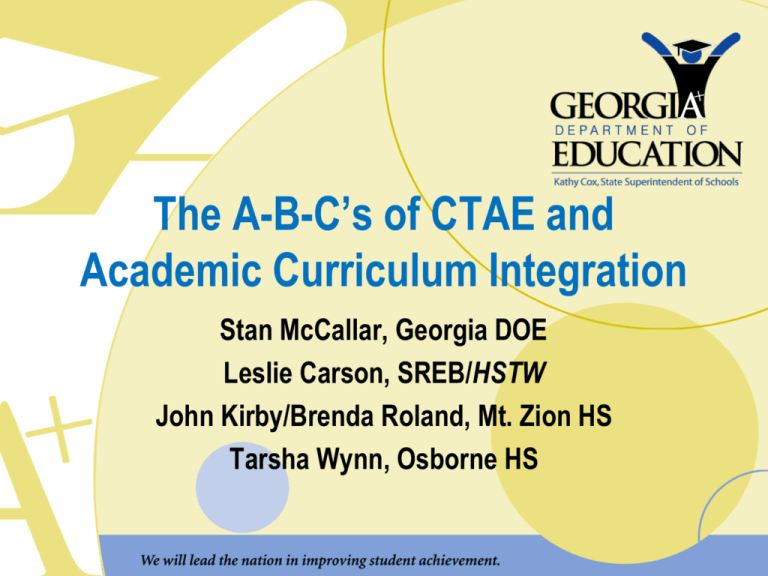
The A-B-C’s of CTAE and Academic Curriculum Integration Stan McCallar, Georgia DOE Leslie Carson, SREB/HSTW John Kirby/Brenda Roland, Mt. Zion HS Tarsha Wynn, Osborne HS CTAE and Academic Integration in GA • Training of school teams in Spring 2008. – Two two-day training events for development of authentic integrated project units – On-site coaching visit • Unit editing for online repository • Survey of school teams eight months after training 8-Step Model for CTAE/Academic Integration Step One: Step Two: Step Three: Step Four: Step Five: Step Six: Step Seven: Step Eight: Choose a CTAE project Look for embedded academics Identify literacy and 21st century skills students will apply Develop a summative assessment Develop a pre-assessment Develop instructional strategies for the CTAE classroom Develop instructional strategies for the academics classroom Prepare a document describing the project activities. Supporting Data • 54% of CTAE teachers now look for embedded math and provide instruction for it. • 11% of CTAE teachers continue to work with a math teacher to plan integrated instruction. • 64% of math teachers have added some contextual instruction to their math classes. Additional Supporting Data • 100% of math support class students at Grady HS passed the Georgia High School Graduation Exam in Spring 2009 as a result of ongoing collaboration between the math teacher and the health sciences teacher • Teachers involved in the project continue to develop authentic integrated anchor projects: Stephenson HS, Grady HS and Albany, for example • Mathematics and CTAE teachers in Dekalb County are using online units. Barriers • Common planning time • Lack of administrative support Success requires: Teachers and administrators must see a project such as this one as a part of a larger whole school reform; and, Successful teams include the right team members who have the direct support of administration. Restaurant Project John Kirby – Engineering & Technology Brenda Roland – Mathematics Mount Zion High School Clayton County Public Schools Designing a Restaurant • Math concepts – proportions, measurement, frequency tables, dispersions, word problems, etc. • CT concepts – design process, floor plan designs, logo designs, menu planning, advertising, management implementation, marketing, and presenting • Product or performance assessment – bell ringers, pretest / post test, rubrics, project samples, presentations, etc. Benefits to Students and Teachers • CT students improved math skills from pre to post test • Math has infused activities to align with preparation for the GHSGT and EOCT • When teachers of different disciplines work together the students see the relevance for both subjects Barriers • Barriers we encountered — lack of common planning time, not teaching the same students, targeting relevant integration ideas • Overcoming of barriers – continued discussing strategies before or after school, warm ups or bell ringers for math classes and CT classes, discussions of relevant math assignments for both programs Since the Training… • Presented to other teachers at the HSTW Summer Conference • Developed / Developing additional units of study for math integration activities – floor coverings, heating & air calculations, pouring concrete calculations and predictive analysis activities, etc. • Begin working with a science/CTAE teacher for Activities Using Engineering by Design and Engineering the Future Curriculum Gadgets and Gizmos Tarsha Wynn – Engineering Drawing & Design Teacher R.L. Osborne High School Cobb County Project Description Math Standards: • P1, P2, P3, P4, P5 • M6M2, M6G1 • M7G1 • M8G1 • MM2G1 • MM2G3 CT concepts ACT-IED 2 ACT-IED 3 ACT-IED 4 • The project will teach students about the process involved in proposing and creating a product of a simple mechanical nature. Benefits to Students and Teachers • Project ideas created together. • Standards explored together. • Lesson ideas created together, lesson implementation completed individually. • Math concepts reinforced between CTAE and Math classes. • Manufacturing and business concepts introduced. Barriers • Proximity: We work in different buildings, meeting together was challenging. • The Engineering Drawing Class had just started the unit in question, eliminating the possibility of a pretest. • Math EOCT and Advanced Placement testing considerations prevented the Geometry class from reviewing concepts already visited until after the EOCT. Since the Training… • My collaborating teacher did not return to Osborne High School. • The ideology behind the project was introduced to the CTE and counseling department. • My CTE section was taught to my students. • More math concepts have been extracted and explained from units. 2009 CTAE/HSTW Workshops • We are tentatively making plans to have math, science, CTAE integration workshops on a regional basis in the fall. Additional information will be forthcoming. www.gadoe.org/ci_cta.aspx Please complete the evaluation form for this session, found in your conference program and turn it in at the door as you leave. Thank you!
